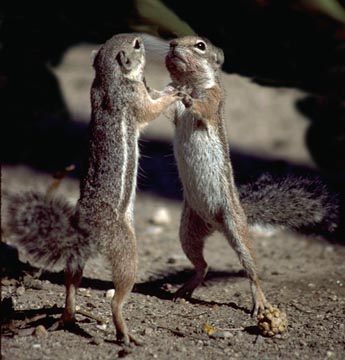When people first reached the deserts of America's southwest they were hungry!


As far as the eye could see, there was nothing but dry, barren land punctuated with a few plants covered in thorns or sharp spines.
Sometimes people would see long-eared jackrabbits, but even the tiniest hare knew how to run fast and hide away in the desert, so for a long time, people just looked at all that land and wondered how they could ever live in a desert!
But Native Americans were hungry, so they caught the little squirrels, tossed them on the fire until the fur singed off, then popped the juicy meat into their mouths and chewed away with grateful sighs of:

Ground squirrels are often mistaken for prairie dogs, so some people think ground squirrels were really the very first great American "hot" dog!

Because these little squirrels are so tasty,
people paid alot of attention to them, and quickly discovered ground squirrels could teach them alot about how to survive in the desert.
Squirrels knew which plants were safe to eat, and more importantly, when it was safe to eat them!
Just like people get sick from eating green
cherries instead of waiting for them to grow red and ripen, the squirrels knew the exact day when a cactus fruit would be ripe and juicy.
By watching the squirrels, people could see it was much easier and safer to get rid of all those tiny, sharp spines protecting the fruit by simply rolling the fruit over the sand a few times until all the spines fell off. Then, like the squirrels, they could pop it into their mouths and gratefully sigh,

Cactus fruit tastes so good that even today Native Americans in the southwest continue to make jam and some wonderful
summer drinks from ripe cactus fruit.
It may look like this squirrel is smelling a prickly pear cactus flower, but the squirrel is really there to lick off all the tasty insects the flower attracts. The Squirrel gets the insects and the flower gets pollinated.
 Squirrels also taught the people how to be good farmers.
Squirrels also taught the people how to be good farmers.
As the squirrel exchanges pollen from flower to flower, it improves chances for flower to bear fruit, that the fruit will bear good seeds, and that hopefully a few seeds will fall unnoticed to the ground and grow up to be more cactus bearing flowers, fruit, and seeds!
Because there are so many hungry creatures
looking for something to eat in the desert, seeds seldom escape
being eaten, so cactus found another way to grow.
Sometimes when squirrels are fighting - or escaping from birds, snakes and coyotes, they bump into a cactus spine, the spine sticks into the squirrel, and when the squirrel tries to wriggle away, a bit of the cactus breaks off and clings to the squirrel's fur until the squirrel can find a safe place where it can stop and painlessly remove the cactus.
Wherever that bit of cactus lands, it will use all its strength and moisture reserves to send down roots so it can grow into a new plant.
But the cactus must grow quickly, because lying
on the ground, it is in danger of being eaten, especially any soft part of it where spines have fallen off!
Sometimes people try to suck out the moisture from a cactus, but the squirrels teach us that sucking on cactus at the wrong time of year will not make your tummy very happy with you!
Native Americans also learned from the squirrels
that they could eat the "beans" (seeds) from palo verde
and mesquite trees But people didn't like the taste of those beans very much, so they did what just what your mother does - they mixed all those nourishing beans into other food people like to eat, like hot fry bread! Native Americans also learned alot about social
behavior from squirrels.
Anyone can watch squirrels for a few days and see one squirrel behaves just like your mother/brother/aunt/uncle, and another squirrel acts just like your best friend - or the school bully!
I was so surprised I jumped straight up, and that surprised the hawk so much it dropped the squirrel!
The hawk landed on the ground a few feet away looking totally bewildered by what had just happened.
The squirrel was in shock from its narrow escape from death, so it ran straight up to the hawk just like the hawk was another squirrel, jumping up and down and screaming its outrage at being attacked.
The hawk seemed to be totally confused at what was happening.
When the squirrel realized its ranting and raving were having absolutely no affect on the big hawk, and that it couldn't jump high enough to shout eyeball to eyeball with the hawk, the squirrel made a direct attack on the hawk's feet!
The hawk very quickly decided "Now would be a good time to leave", and flew away. As soon as the hawk flew away, I noticed its sharp talons had sliced right through to the bone on both sides of the little squirrel.
Almost at the same time, the squirrel realized how badly it was
hurt and fell down on the ground. Suddenly, from every direction, squirrels came rushing to his aid! He was an instant hero!
All the squirrels had seen him fearlessly attack the giant hawk, and as the days passed, they began to treat him less as an hero, and more like a god.
Everything the "hero" squirrel wanted was brought to him. With all that attention, his wounds quickly healed, but he also became too fat - and too lazy, to forage for his own food.
As the days passed, the "hero" squirrel got thinner and thinner, weaker and weaker, and meaner and meaner because he liked being treated like a god, but now, none of the other squirrels
would come near him because he had such a bad temper. It only took a few more weeks before the "hero" died all alone and neglected. So, with squirrels instead of school books,
Native Americans were able to learn many of life's good lessons
just by watching them. As you observe squirrels scurrying about, you can see they live their lives at a much faster pace than we do! Today, no one eats ground squirrels anymore
because there is always plenty of instant food at the supermarket, and
a supermarket is always open. It doesn't matter when people
feel hungry, because today there is always a convenient store to buy food.
Native Americans stopped eating ground squirrels
after Word War II ended, because Native Americans who served as soldiers were taught that it isn't healthy to eat animals without first "dressing" them ("dressing" animals really means "gutting" - removing their intestines and vital organs). Old timers quickly discovered that dressed up squirrels don't taste anything like squirrel au naturale (old-fashioned hot dogs), plus it took too much time to prepare the squirrels for such a tiny amount of meat, so squirrels became playmates - (or pests) leaving hawks, snakes and coyotes to sing 
(like TARZAN, squirrels love to climb trees
and fill the desert air with "King of the Mountain"
calls or shrill whistles warning other squirrels of approaching
danger).
 One morning, I was flat on the ground
photographing a squirrel busy rubbing the spines off of a cactus fruit
when suddenly there was a whoosh, and out of nowhere a red-tailed hawk swooped down and snatched up the squirrel with its talons.
One morning, I was flat on the ground
photographing a squirrel busy rubbing the spines off of a cactus fruit
when suddenly there was a whoosh, and out of nowhere a red-tailed hawk swooped down and snatched up the squirrel with its talons. 
 The other squirrels soon realized their Champion
was no longer fit to fight hawks - or other squirrels, so they stopped
catering to his needs.
The other squirrels soon realized their Champion
was no longer fit to fight hawks - or other squirrels, so they stopped
catering to his needs.

 All the live-long day!
All the live-long day!
 * * * *
Hawaiian Story * * * *
* * * *
Hawaiian Story * * * *

Angelfire - Free Home Pages
Free Web Building Help
Lycos - Search the Web
CareerPath - Where Employers and Employees Click
Thank you for visiting my page at Angelfire. Please come back and visit again!